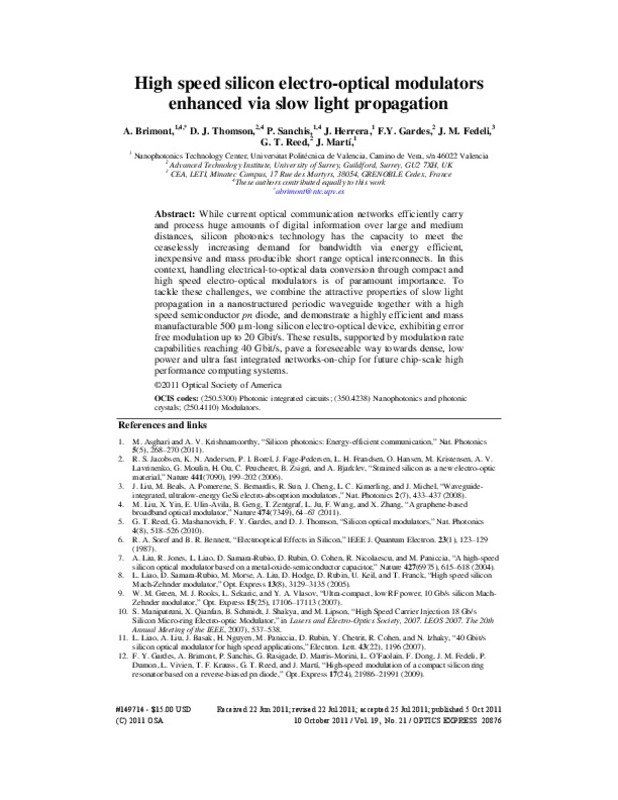JavaScript is disabled for your browser. Some features of this site may not work without it.
Buscar en RiuNet
Listar
Mi cuenta
Estadísticas
Ayuda RiuNet
Admin. UPV
Performance Comparison of OFDM-UWB Radio Signals Distribution in Long-Reach PONs Using Mach-Zehnder and Linearized Modulators
Mostrar el registro sencillo del ítem
Ficheros en el ítem
| dc.contributor.author | Alves, Tiago
|
es_ES |
| dc.contributor.author | Morant, Maria
|
es_ES |
| dc.contributor.author | Cartaxo, Adolfo
|
es_ES |
| dc.contributor.author | Llorente, Roberto
|
es_ES |
| dc.date.accessioned | 2014-04-04T12:31:32Z | |
| dc.date.issued | 2011-06 | |
| dc.identifier.issn | 0733-8716 | |
| dc.identifier.uri | http://hdl.handle.net/10251/36840 | |
| dc.description.abstract | [EN] The performance of orthogonal frequency division multiplexing ultra wideband (UWB) radio signals distribution in long-reach passive optical networks (LR-PONs) using conventional chirp-less Mach Zehnder (MZ) and linearized (L) Y-fed directional couplers electro-optic modulators (EOMs) is compared. Particularly, the optimum modulation index and the corresponding minimum optical signal-to-noise ratio (OSNR) required to achieve a bit error probability of 10 -12 are evaluated through numerical simulation for systems operating with single and three UWB sub-bands and different standard single-mode fiber (SSMF) distances indicated for LR-PONs. Both modulators are characterized experimentally and theoretical model parameters are adjusted to correctly describe the power and chirp characteristics of the electro-optic conversion in the simulation process. It is shown that the optimum modulation index and the tolerance to modulation index variations, considering either single or multi band UWB operation, is approximately two times higher for systems employing L-EOM than MZ-EOM. Additionally, with MZ-EOM, the required OSNR may increase considerably when the fiber length increases due to the power fading induced by fiber chromatic dispersion, achieving a penalty of almost 3 dB for systems with 100 km of SSMF and single UWB sub-band operation. Instead, with L-EOM, the required OSNR penalty (when compared with the back-to-back case) is lower for fiber lengths up to 100 km than it is for systems employing the MZ-EOM modulator due to the combined effect of the chirp generated by the modulator and the chromatic dispersion. | es_ES |
| dc.description.sponsorship | This work was supported in part by the Fundacao para a Ciencia e a Tecnologia (FCT) project TURBO-PTDC/EEA-TEL/104358/2008 from Portugal and by the EU project UCELLS-FP7-IST-1-216785. The work of T. Alves and M. Morant were supported by FCT under contract SFRH/BD/29871/2006 and by Spain FPU MEC grant AP2007-01413, respectively. | en_EN |
| dc.format.extent | 10 | es_ES |
| dc.language | Inglés | es_ES |
| dc.publisher | Institute of Electrical and Electronics Engineers (IEEE) | es_ES |
| dc.relation.ispartof | IEEE Journal on Selected Areas in Communications | es_ES |
| dc.rights | Reserva de todos los derechos | es_ES |
| dc.subject | Electro-optic modulation | es_ES |
| dc.subject | Linearized modulator | es_ES |
| dc.subject | Mach-Zehnder modulator | es_ES |
| dc.subject | Orthogonal frequency division multiplexing | es_ES |
| dc.subject | Passive optical networks | es_ES |
| dc.subject | Ultra wideband | es_ES |
| dc.subject | Linearized modulators | es_ES |
| dc.subject | Mach Zehnder modulator | es_ES |
| dc.subject | Orthogonal frequency division | es_ES |
| dc.subject | Bit error rate | es_ES |
| dc.subject | Chirp modulation | es_ES |
| dc.subject | Chromatic dispersion | es_ES |
| dc.subject | Computer simulation | es_ES |
| dc.subject | Dispersions | es_ES |
| dc.subject | Fading (radio) | es_ES |
| dc.subject | Fiber optic networks | es_ES |
| dc.subject | Fibers | es_ES |
| dc.subject | Linearization | es_ES |
| dc.subject | Modulation | es_ES |
| dc.subject | Multiplexing | es_ES |
| dc.subject | Optical signal processing | es_ES |
| dc.subject | Passive networks | es_ES |
| dc.subject | Signal to noise ratio | es_ES |
| dc.subject | Single mode fibers | es_ES |
| dc.subject | Ultra-wideband (UWB) | es_ES |
| dc.subject | Light modulators | es_ES |
| dc.subject.classification | TEORIA DE LA SEÑAL Y COMUNICACIONES | es_ES |
| dc.title | Performance Comparison of OFDM-UWB Radio Signals Distribution in Long-Reach PONs Using Mach-Zehnder and Linearized Modulators | es_ES |
| dc.type | Artículo | es_ES |
| dc.embargo.lift | 10000-01-01 | |
| dc.embargo.terms | forever | es_ES |
| dc.identifier.doi | 10.1109/JSAC.2011.110618 | |
| dc.relation.projectID | info:eu-repo/grantAgreement/MEC//AP2007-01413/ES/AP2007-01413/ | es_ES |
| dc.relation.projectID | info:eu-repo/grantAgreement/FCT/3599-PPCDT/104358/PT/Transmission of UltRa wide-Band radio signals over Optical fiber - TURBO/ | |
| dc.relation.projectID | info:eu-repo/grantAgreement/FCT/SFRH/SFRH/BD/29871/2006/PT/ | |
| dc.relation.projectID | info:eu-repo/grantAgreement/EC/FP7/216785/EU/Ultra-wide band real-time interference monitoring and CELLular management Strategies/ | |
| dc.rights.accessRights | Cerrado | es_ES |
| dc.contributor.affiliation | Universitat Politècnica de València. Instituto Universitario de Tecnología Nanofotónica - Institut Universitari de Tecnologia Nanofotònica | es_ES |
| dc.contributor.affiliation | Universitat Politècnica de València. Departamento de Comunicaciones - Departament de Comunicacions | es_ES |
| dc.description.bibliographicCitation | Alves, T.; Morant, M.; Cartaxo, A.; Llorente, R. (2011). Performance Comparison of OFDM-UWB Radio Signals Distribution in Long-Reach PONs Using Mach-Zehnder and Linearized Modulators. IEEE Journal on Selected Areas in Communications. 29(6):1311-1320. https://doi.org/10.1109/JSAC.2011.110618 | es_ES |
| dc.description.accrualMethod | S | es_ES |
| dc.relation.publisherversion | http://dx.doi.org/10.1109/JSAC.2011.110618 | es_ES |
| dc.description.upvformatpinicio | 1311 | es_ES |
| dc.description.upvformatpfin | 1320 | es_ES |
| dc.type.version | info:eu-repo/semantics/publishedVersion | es_ES |
| dc.description.volume | 29 | es_ES |
| dc.description.issue | 6 | es_ES |
| dc.relation.senia | 209388 | |
| dc.contributor.funder | Fundação para a Ciência e a Tecnologia, Portugal | |
| dc.contributor.funder | Ministerio de Educación y Ciencia | |
| dc.contributor.funder | European Commission |






![[Cerrado]](/themes/UPV/images/candado.png)



